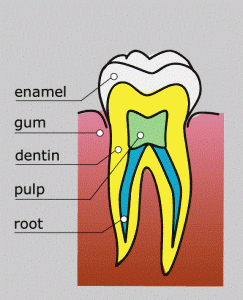By failing to look after your gums you increase the risk of the gums becoming inflamed and turning into gingivitis. If this is left untreated it can progress into the more serious condition periodontitis which can ultimately lead to tooth loss. Not only is this unattractive but it can be costly to replace missing teeth, and so we recommend that you do everything you can to look after your teeth and gums.
In this series of two blog posts we will look at gingivitis and periodontitis, what causes these conditions, how you can spot them and then in the second blog post we will look at the treatments on offer.
Gum disease and gingivitis
 Gum disease, which includes periodontal disease, is inflammation and infection that destroys the tissues that support the teeth, including the gums, the periodontal ligaments and the tooth sockets (alveolar bone). Gum disease affects more than half of the adult population with natural teeth. It can be treated by a dentist or hygienist and in the early stages the effects can be reversed. There are two main types of gum disease:
Gum disease, which includes periodontal disease, is inflammation and infection that destroys the tissues that support the teeth, including the gums, the periodontal ligaments and the tooth sockets (alveolar bone). Gum disease affects more than half of the adult population with natural teeth. It can be treated by a dentist or hygienist and in the early stages the effects can be reversed. There are two main types of gum disease:
Gingivitis is inflammation of the gums. Gingivitis is due to the long term effects of plaque deposits on your teeth. Plaque is a sticky material made of bacteria, mucus and food debris that develops on the exposed parts of the teeth. If you do not remove plaque, it turns into a hard deposit called tartar (or calculus) that becomes trapped at the base of the tooth. Plaque and tartar irritate and inflame the gums. Bacteria and the toxins they produce cause the gums to become infected, swollen and tender. You may notice bleeding on brushing or a bad taste in the mouth.
Risks for gingivitis
- Certain infections and systemic diseases
- Poor dental hygiene, stress and smoking
- Pregnancy
- Uncontrolled diabetes
- Misaligned teeth, rough edges of filling, ill- fitting mouth appliances (such as braces, dentures, bridges and crowns)
- Use of certain medications
Symptoms of gingivitis
- Bleeding gums
- Red or purple appearance to gums
- Tender and swollen gums
- Mouth ulcers
- Shiny appearance to gums
Periodontitis occurs when inflammation or infection of the gums (gingivitis) is untreated or treatment delayed. Infection and inflammation spreads from the gums to the ligaments and bone that support the teeth. Loss of support causes the teeth to become loose and eventually fall out. Periodontitis is the primary cause of tooth loss in adults. Plaque and tartar build up at the base of the teeth.
Inflammation causes a pocket to develop between the gums and the teeth, which fills with plaque and tartar. Soft tissue swelling traps the plaque in the pocket. Continued inflammation leads to damage of the tissues and bone surrounding the tooth. Because plaque contains bacteria, infection is likely and a tooth abscess may develop, which increases the rate of bone destruction and may lead to eventual tooth loss.
Risks for periodontitis
- Genetics i.e family history
- Diabetes
- Poor nutrition, smoking and stress
- Pregnancy-may lead to delivery of pre-term babies
- HIV and associated infections
- Rheumatoid arthritis
- Clenching/grinding teeth
- Some medications
- Cardiovascular disease
Researchers have found that people with gum disease are almost twice as likely to suffer from coronary heart disease. This type of heart disease occurs when plaque (deposits of fat, cholesterol, calcium and other material) form in the walls of the coronary arteries causing the walls to become thicker. This limits the amount of oxygen and nutrients that are necessary for proper heart function.
Bacteria from gum disease enters the bloodstream and connects to the plaque in the coronary arteries, possibly contributing to the formation of blood clots.
Watch out for the second post in this series which talks about the treatments for both gingivitis and periodontitis, this will be posted on this blog on Friday, 6th September.
Dr Nishan Dixit
Latest posts by Dr Nishan Dixit (see all)
- Dr Dixit is the new President of British Academy of Cosmetic Dentistry - 28 May 2020
- Does Invisalign hurt? - 9 March 2020
- How Long Does Invisalign Take? - 27 February 2020

